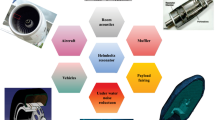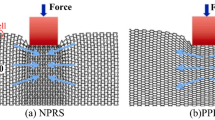Abstract
Uncertainties existing in the acoustic metamaterial may strongly affect its unusual properties. Aiming at this actuality, the interval model is introduced to treat with uncertainties existing in the acoustic metamaterial with Helmholtz resonators. Frequency intervals in which the sound intensity transmission coefficients are certainly less than the required value and the effective bulk moduli are certainly negative are defined as conservative approximations. Frequency intervals in which the sound intensity transmission coefficients may be less than the required value and the effective bulk moduli may be negative are defined as unsafe approximations. The proportion of the conservative approximation and the unsafe approximation is defined as an approximate precision. Based on the quantification of uncertainties of the sound intensity transmission coefficients and the negative effective bulk moduli, an optimization model for the interval acoustic metamaterial with Helmholtz resonators is constructed. Numerical results showed that even suffering from effects of interval parameters, unusual properties of the optimized acoustic metamaterial (such as the bandgap of the sound transmission and the negative effective bulk modulus) could be improved.
Similar content being viewed by others
References
Popa B I, Zigoneanu L, Cummer S A. Experimental acoustic ground cloak in air. Phys Rev Lett, 2011, 106: 253901
Deng K, Ding Y, He Z, et al. Theoretical study of subwavelength imaging by acoustic metamaterial slabs. J Appl Phys, 2009, 105: 124909
Deckers E, Claeys C, Atak O, et al. A wave based method to predict the absorption, reflection and transmission coefficient of two-dimensional rigid frame porous structures with periodic inclusions. J Comp Phys, 2016, 312: 115–138
Xia B, Dai H, Yu D. Symmetry-broken metamaterial for blocking, cloaking, and supertunneling of sound in a subwavelength scale. Appl Phys Lett, 2016, 108: 251902
Atak O, Huybrechs D, Pluymers B, et al. The design of Helmholtz resonator based acoustic lenses by using the symmetric multi-level wave based method and genetic algorithms. J Sound Vib, 2014, 333: 3367–3381
Zhu R, Liu X N, Hu G K, et al. Negative refraction of elastic waves at the deep-subwavelength scale in a single-phase metamaterial. Nat Commun, 2014, 5: 5510
Langfeldt F, Gleine W, von Estorff O. Analytical model for low-frequency transmission loss calculation of membranes loaded with arbitrarily shaped masses. J Sound Vib, 2015, 349: 315–329
Langfeldt F, Riecken J, Gleine W, et al. A membrane-type acoustic metamaterial with adjustable acoustic properties. J Sound Vib, 2016, 373: 1–18
Liu Z, Zhang X, Mao Y, et al. Locally resonant sonic materials. Science, 2000, 289: 1734–1736
Goffaux C, Sánchez-Dehesa J, Yeyati A L, et al. Evidence of fano-like interference phenomena in locally resonant materials. Phys Rev Lett, 2002, 88: 225502
Ding Y, Liu Z, Qiu C, et al. Metamaterial with simultaneously negative bulk modulus and mass density. Phys Rev Lett, 2007, 99: 093904
Wu Y, Lai Y, Zhang Z Q. Elastic metamaterials with simultaneously negative effective shear modulus and mass density. Phys Rev Lett, 2011, 107: 105506
Fang N, Xi D, Xu J, et al. Ultrasonic metamaterials with negative modulus. Nat Mater, 2006, 5: 452–456
Yang Z, Mei J, Yang M, et al. Membrane-type acoustic metamaterial with negative dynamic mass. Phys Rev Lett, 2008, 101: 204301
Lee S H, Park C M, Seo Y M, et al. Composite acoustic medium with simultaneously negative density and modulus. Phys Rev Lett, 2010, 104: 054301
Yang M, Ma G, Yang Z, et al. Coupled membranes with doubly negative mass density and bulk modulus. Phys Rev Lett, 2013, 110: 134301
Meidani M, Kim E, Li F, et al. Tunable evolutions of wave modes and bandgaps in quasi-1D cylindrical phononic crystals. J Sound Vib, 2015, 334: 270–281
Kim E, Yang J. Wave propagation in single column woodpile phononic crystals: Formation of tunable band gaps. J Mech Phys Solids, 2014, 71: 33–45
Zhu Z W, Deng Z C. Tailoring of interiorly resonant band gaps in structurally square re-entrant honeycombs. J Sound Vib, 2016, 372: 181–191
Li J B, Wang Y S, Zhang C. Tuning of acoustic bandgaps in phononic crystals with Helmholtz resonators. J Vib Acoust, 2013, 135: 031015
Hao L, Ding C, Zhao X. Design of a passive controllable negative modulus metamaterial with a split hollow sphere of multiple holes. J Vib Acoust, 2013, 135: 041008
Romero-Garciá V, Sánchez-Pérez J V, Garcia-Raffi L M, et al. Hole distribution in phononic crystals: Design and optimization. J Acoust Soc Am, 2009, 125: 3774–3783
Romero-García V, Krynkin A, Garcia-Raffi L M, et al. Multi-resonant scatterers in sonic crystals: Locally multi-resonant acoustic metamaterial. J Sound Vib, 2013, 332: 184–198
Wang Y F, Wang Y S. Complete bandgap in three-dimensional holey phononic crystals with resonators. J Vib Acoust, 2013, 135: 041009
Xu W, Wang W, Yang T. Multi-objective optimization of layered elastic metamaterials with multiphase microstructures. J Vib Acoust, 2013, 135: 041010
Acar G, Yilmaz C. Experimental and numerical evidence for the existence of wide and deep phononic gaps induced by inertial amplification in two-dimensional solid structures. J Sound Vib, 2013, 332: 6389–6404
Yuksel O, Yilmaz C. Shape optimization of phononic band gap structures incorporating inertial amplification mechanisms. J Sound Vib, 2015, 355: 232–245
Kang Z, Luo Y. Reliability-based structural optimization with probability and convex set hybrid models. Struct Multidisc Optim, 2010, 42: 89–102
Kang Z, Luo Y, Li A. On non-probabilistic reliability-based design optimization of structures with uncertain-but-bounded parameters. Struct Safety, 2011, 33: 196–205
Xia B, Yu D. Modified sub-interval perturbation finite element method for 2D acoustic field prediction with large uncertain-but-bounded parameters. J Sound Vib, 2012, 331: 3774–3790
Xia B, Yu D, Liu J. Interval and subinterval perturbation methods for a structural-acoustic system with interval parameters. J Fluids Struct, 2013, 38: 146–163
Gao W, Song C, Tin-Loi F. Probabilistic interval analysis for structures with uncertainty. Struct Safety, 2010, 32: 191–199
Wu D, Gao W, Tangaramvong S, et al. Robust stability analysis of structures with uncertain parameters using mathematical programming approach. Int J Numer Meth Eng, 2014, 100: 720–745
Wu D, Gao W, Song C, et al. Probabilistic interval stability assessment for structures with mixed uncertainty. Struct Safety, 2016, 58: 105–118
Li F, Luo Z, Rong J, et al. Interval multi-objective optimisation of structures using adaptive Kriging approximations. Comp Struct, 2013, 119: 68–84
Hu W, Azarm S, Almansoori A. New approximation assisted multiobjective collaborative robust optimization (new AA-McRO) under interval uncertainty. Struct Multidisc Optim, 2013, 47: 19–35
Mortazavi A, Azarm S, Gabriel S A. Adaptive gradient-assisted robust design optimization under interval uncertainty. Eng Optim, 2013, 45: 1287–1307
Hurtado J E, Alvarez D A. The encounter of interval and probabilistic approaches to structural reliability at the design point. Comp Methods Appl Mech Eng, 2012, 225-228: 74–94
Tangaramvong S, Wu D, Gao W, et al. Response bounds of elastic structures in the presence of interval uncertainties. J Struct Eng, 2015, 141: 04015046
Wu J, Luo Z, Zhang Y, et al. Interval uncertain method for multibody mechanical systems using Chebyshev inclusion functions. Int J Numer Meth Eng, 2013, 95: 608–630
Wu J, Gao J, Luo Z, et al. Robust topology optimization for structures under interval uncertainty. Adv Eng Software, 2016, 99: 36–48
Yang C, Tangaramvong S, Gao W, et al. Interval elastoplastic analysis of structures. Comp Struct, 2015, 151: 1–10
Zi B, Zhou B. A modified hybrid uncertain analysis method for dynamic response field of the LSOAAC with random and interval parameters. J Sound Vib, 2016, 374: 111–137
Han X, Jiang C, Liu L X, et al. Response-surface-based structural reliability analysis with random and interval mixed uncertainties. Sci China Tech Sci, 2014, 57: 1322–1334
Li L Y, Lu Z Z, Li W. State dependent parameter method for importance analysis in the presence of epistemic and aleatory uncertainties. Sci China Tech Sci, 2012, 55: 1608–1617
Du X. Reliability-based design optimization with dependent interval variables. Int J Numer Meth Eng, 2012, 91: 218–228
Xia B, Lü H, Yu D, et al. Reliability-based design optimization of structural systems under hybrid probabilistic and interval model. Comp Struct, 2015, 160: 126–134
Kang Z, Bai S. On robust design optimization of truss structures with bounded uncertainties. Struct Multidisc Optim, 2013, 47: 699–714
Doltsinis I, Kang Z. Robust design of structures using optimization methods. Comp Methods Appl Mech Eng, 2004, 193: 2221–2237
Kinsler L E. Fundamentals of Acoustic (3th ed). New York: John Wiley and Sons, 1982
Wang Y, Gao J, Luo Z, et al. Level-set topology optimization for multimaterial and multifunctional mechanical metamaterials. Eng Optim, 2016, 49: 22–42
Wang Y, Luo Z, Zhang N, et al. Topological shape optimization of multifunctional tissue engineering scaffolds with level set method. Struct Multidisc Optim, 2016, 54: 333–347
Wang Y, Luo Z, Zhang N, et al. Topological design for mechanical metamaterials using a multiphase level set method. Struct Multidisc Optim, 2016, 54: 952–937
Author information
Authors and Affiliations
Corresponding author
Rights and permissions
About this article
Cite this article
Xia, B., Qin, Y., Chen, N. et al. Optimization of uncertain acoustic metamaterial with Helmholtz resonators based on interval model. Sci. China Technol. Sci. 60, 385–398 (2017). https://doi.org/10.1007/s11431-016-0562-1
Received:
Accepted:
Published:
Issue Date:
DOI: https://doi.org/10.1007/s11431-016-0562-1




